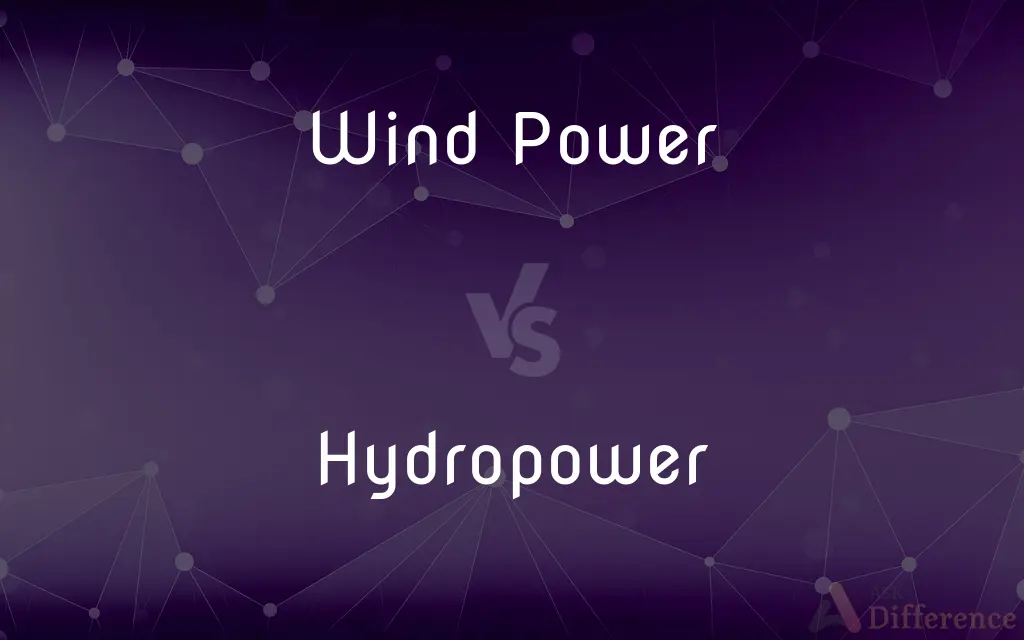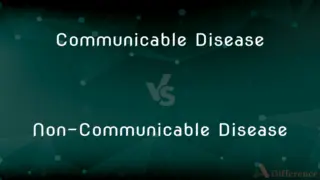Wind Power vs. Hydropower — What's the Difference?
By Fiza Rafique & Maham Liaqat — Published on August 8, 2024
Wind power harnesses air flow to generate electricity, suitable for areas with consistent wind, while hydropower uses water flow, ideal for regions with significant water bodies.

Difference Between Wind Power and Hydropower
Table of Contents
ADVERTISEMENT
Key Differences
Wind power and hydropower are two prominent renewable energy sources, each utilizing different natural resources to generate electricity. Wind power captures the kinetic energy of wind through turbines, converting it into electrical energy. It is particularly effective in areas with consistent and strong wind patterns. Hydropower, on the other hand, relies on the flow of water, typically from rivers or stored in reservoirs behind dams, to turn turbines and generate electricity. This method is most suited to regions with significant water bodies and elevation changes.
The infrastructure for wind power includes wind turbines, which can be installed onshore or offshore. These turbines have a lower environmental impact during operation but can affect landscapes and wildlife, particularly birds and bats. Hydropower plants, especially large-scale dams, can have a significant environmental impact, including altering river ecosystems, affecting water quality, and displacing communities. However, they often provide benefits such as water storage for irrigation and flood control.
In terms of energy production, wind power output can be variable, depending on wind speed and consistency. This variability can make wind power less predictable than hydropower, which typically offers a more stable and continuous energy supply, contingent on water availability. Hydropower's ability to store energy through pumped storage is an advantage for balancing electricity supply and demand.
The initial investment and maintenance costs can vary significantly between the two. Wind power projects generally have lower upfront costs and quicker deployment times than large hydropower projects. However, the lifespan of a wind turbine is shorter compared to a hydropower plant, which can operate efficiently for decades, potentially making hydropower more cost-effective in the long term.
Both wind power and hydropower contribute to reducing dependence on fossil fuels and lowering greenhouse gas emissions. However, the choice between them often depends on geographic, environmental, and economic factors specific to the location. Combining various renewable energy sources, including wind and hydro, can provide a more reliable and sustainable energy system.
ADVERTISEMENT
Comparison Chart
Energy Source
Wind
Water flow
Environmental Impact
Lower during operation, affects wildlife
Can alter ecosystems, provides irrigation/flood control
Predictability
Variable, depends on wind
More stable, depends on water availability
Initial Investment
Generally lower, quicker deployment
Higher, especially for large dams
Maintenance Costs
Lower but shorter lifespan
Higher but longer lifespan
Energy Storage
Limited without batteries
Possible through pumped storage
Best Suited Regions
Areas with strong, consistent winds
Regions with significant water bodies, elevation changes
Benefits
Reduces fossil fuel dependence, lowers emissions
Also offers water management benefits
Compare with Definitions
Wind Power
Lower impact, but may affect avian wildlife.
Turbine placement considers bird migration paths.
Hydropower
Less variable than wind.
Hydropower plants provide a consistent electricity source.
Wind Power
Depends on wind consistency.
Wind farms produce more power during windy seasons.
Hydropower
Generates electricity through water.
Dams convert river flow into a steady power supply.
Wind Power
Reduces greenhouse gas emissions.
Wind farms are crucial in transitioning to renewable energy.
Hydropower
Higher initial costs, but longer operational life.
Many dams are designed to last over 50 years.
Wind Power
Lower upfront costs, faster to install.
Small wind projects can be completed within a year.
Hydropower
Can alter river ecosystems, but offers flood control.
Dams are designed with fish ladders to mitigate impacts.
Wind Power
Generates electricity from wind.
Wind turbines efficiently capture coastal winds.
Hydropower
Provides water storage, irrigation.
Reservoirs support agriculture and drinking water supply.
Hydropower
Hydroelectric power.
Hydropower
Hydroelectric power
Common Curiosities
Can wind power be stored like hydropower?
Wind energy storage is possible with batteries, but hydropower can more efficiently store energy through pumped storage methods.
Which is more reliable, wind power or hydropower?
Hydropower is generally more reliable due to the predictable nature of water flow, whereas wind power can vary with wind conditions.
What are the challenges in increasing wind and hydropower capacity?
Challenges include environmental concerns, investment costs, and finding suitable locations that maximize energy production while minimizing impacts.
What makes wind power and hydropower renewable energy sources?
Both utilize naturally replenishing resources—wind and water flow—to generate electricity, minimizing environmental impact compared to fossil fuels.
How do the environmental impacts of wind and hydro compare?
Wind power has a lower impact during operation but can affect wildlife; hydropower can significantly alter ecosystems but provides benefits like flood control.
Are there any regions where combining wind and hydro is beneficial?
Yes, regions that have both resources can use them complementarily to provide a more stable and reliable energy supply.
How do wind and hydro power contribute to reducing climate change?
By generating electricity without burning fossil fuels, both wind and hydropower reduce greenhouse gas emissions, contributing to climate change mitigation.
Can hydropower plants affect local communities?
Yes, large dam projects can displace communities and alter local environments, necessitating careful planning and mitigation measures.
Is wind power more suitable for certain types of locations than hydropower?
Yes, wind power is best suited for areas with strong and consistent winds, while hydropower requires sufficient water flow and elevation changes.
What role do technological advancements play in wind and hydropower efficiency?
Technological improvements continue to increase the efficiency, reliability, and environmental compatibility of both wind and hydropower systems.
Which has a faster deployment time, wind turbines or hydro plants?
Wind turbines can be deployed more quickly than hydropower plants, which require extensive construction and infrastructure.
How does the cost-effectiveness of wind and hydro power compare in the long term?
While wind power has lower initial costs, the longer operational life of hydropower plants may make them more cost-effective over time.
Can existing infrastructure be adapted to enhance wind or hydro power?
Yes, existing dams can be retrofitted for hydropower, and wind turbines can be installed on suitable existing structures or land.
How does the public perceive wind versus hydropower?
Public perception varies, with some communities expressing concerns over environmental and visual impacts, while others support these renewable energy sources for their environmental and economic benefits.
How do governments support wind and hydro power development?
Support can include subsidies, tax incentives, and policies encouraging renewable energy investment and infrastructure development.
Share Your Discovery

Previous Comparison
Apes vs. Human
Next Comparison
Communicable Disease vs. Non-Communicable DiseaseAuthor Spotlight
Written by
Fiza RafiqueFiza Rafique is a skilled content writer at AskDifference.com, where she meticulously refines and enhances written pieces. Drawing from her vast editorial expertise, Fiza ensures clarity, accuracy, and precision in every article. Passionate about language, she continually seeks to elevate the quality of content for readers worldwide.
Co-written by
Maham Liaqat













































